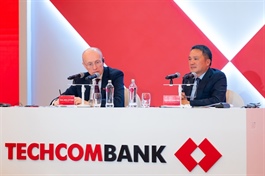Building banking strategy amidst digital storm
Building banking strategy amidst digital storm
With lingering economic uncertainties and unstable macroeconomic conditions, the banking sector is entering a phase marked by tightening budgets and mounting pressure to sustain growth and retain customers.
Against this backdrop, an age-old question suddenly feels more urgent than ever: "Should marketing be the first line item to cut?"
It is a fair question. But stopping at cost reduction without considering return on investment risks falling into a short-term trap, where immediate savings come at the expense of long-term competitive advantage.

Do Ngoc Son, deputy director of market research and Consulting, Mibrand Vietnam |
In today’s environment, marketing in banking is no longer a nice-to-have but a strategic capability, closely tied to customer acquisition, retention, and lifetime value generation.
Yet, questions around marketing effectiveness remain widespread, especially in a context where consumer behaviours are shifting rapidly, personalisation expectations are rising, and technology is rewriting the rules of engagement.
Unlike consumer goods, where value can be seen and experienced instantly, banking products are largely intangible, feature-similar, and heavily reliant on trust. This makes marketing not just a communication function, but a powerful tool to shape perception, trigger behaviours, and define brand positioning in the minds of customers.
However, many industry surveys reveal that marketing budgets are still predominantly allocated to broad-based campaigns, focusing more on product features than on user context and behaviour. As a result, messaging often gets lost in an increasingly crowded stream of financial content.
According to Deloitte’s 2023 report, only 14 per cent of Southeast Asian users could recall the name of a banking product they had seen advertised within the previous seven days, a telling sign of the sector’s struggle to make lasting impressions.
The real issue is not whether banks should invest in marketing, but how their investments reflect a clear strategic mindset. To make marketing a true growth driver, banks must seriously consider three key shifts, starting with a fundamental change in how financial products are developed.
Rather than continuously launching new products with overlapping features, the market is moving towards designing financial solutions tailored to customer life journeys. Today’s customers no longer use a single product to meet every need, they segment their financial tasks from daily payments and goal-based savings to flexible investments and long-term protection.
A 2024 McKinsey study found that 43 per cent of users in Asia-Pacific simultaneously use two to four different financial platforms to meet personalised goals. This calls for a shift in product strategy from designing products to designing integrated financial solutions built around real-life needs and behavioural insights.
The second transformation relates to customer segmentation. It involves moving beyond traditional wealth tiers and adopting multidimensional segmentation based on value and behaviour.
The two-tier wealth segmentation model, while easy to implement, is increasingly showing its limitations. Consumers with the same income or asset levels can have vastly different financial behaviours and expectations.
A 2024 quantitative study by Mibrand revealed that factors such as price sensitivity, deal-seeking behaviour, and habitual spending patterns are playing a larger role in how consumers engage with banks, regardless of their financial tier.
By combining financial value segmentation with behavioural and psychographic profiling, banks can significantly enhance message precision while laying the groundwork for better product development, stronger customer bonds, and higher lifetime value.
The third shift involves the transformation from mass communication to contextual touchpoint activation.
Changes in consumer behaviour have brought new challenges to communication effectiveness. According to Meta, engagement with banking content on digital platforms has dropped over 60 per cent in the past three years, partly due to content fatigue, but also because messaging often lacks specificity and contextual relevance.
Leading financial institutions are now adopting a touchpoint activation approach, focusing on the right channel, at the right moment, with the right need in mind. Instead of blanket social media campaigns, personalised messages delivered through mobile banking apps, timed with high-likelihood moments like lunch breaks or online shopping hours, are showing far higher conversion potential.
Reinvesting in marketing doesn’t have to mean higher spending. On the contrary, now is the right moment for banks to reexamine their budget structures, eliminate low-impact spending, and concentrate resources on core capabilities.
These include leveraging behavioural data for smarter decision-making; building a robust persona library to support both product innovation and communication; integrating personalisation technologies into Customer Relationship Management CRM, Customer Data Platform CDP, and banking apps; and nurturing a multidisciplinary in-house team that combines customer insight, product design, technology, and creative content.
Equally important is a mindset shift in performance measurement from tracking brand awareness alone to measuring real behavioural outcomes.
Cutting costs is a rational response in times of budgetary constraints. But without a corresponding shift in thinking and operational structure, cutting marketing may end up weakening the very foundation that connects brands with their customers.
In a market where product differentiation is fading, the new competitive edge lies in experience and customer understanding. When invested in wisely, marketing will not only drive short-term results, it will also help banks build long-term trust and value, one relationship at a time.
- 18:38 28/04/2025
























